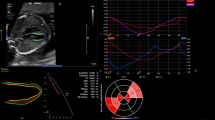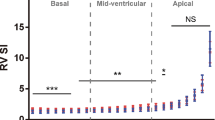Abstract
Purpose
To establish a normal reference range for automated fractional shortening (Auto FS) in normal singleton fetuses measured at multiple centers.
Methods
This study was conducted from May 2017 to March 2019. It was undertaken on normal singleton fetuses. First, a four-chamber view of the fetal heart was recorded in the B-mode. Then, the region of interest was set on the edge of the ventricular septum and on the edge of the ventricular muscle at a point one-third away from the atrioventricular valve and toward the cardiac apex. Tracking was automatically performed. Values measured in the right ventricle were defined as R-Auto FS, and in the left ventricle as L-Auto FS. Furthermore, combined-Auto FS was defined as the measurement across both ventricles.
Results
A total of 442 normal fetuses were assessed. R-Auto FS decreased significantly with gestational age, and L-Auto FS showed a similar tendency (Spearman’s correlation analysis: rs = − 0.415 and rs = − 0.252, respectively). Combined-Auto FS showed a similar decline as the gestational age increased (rs = − 0.451).
Conclusion
In this study, we succeeded in defining a reference Auto FS value not only at one institution but also multiple centers. This study suggests that Auto FS can be used clinically and effectively.




Similar content being viewed by others
References
Nakata M, Sakuma J, Takano M, Nagasaki S. Assessment of fetal cardiac function with echocardiography. J Obstet Gynaecol Res. 2020;46:31–8.
DeVore GR, Klas B, Satou G, Sklansky M. Twenty-four segment transverse ventricular fractional shortening: a new technique to evaluate fetal cardiac function. J Ultrasound Med. 2018;37:1129–41.
Luewan S, Yanase Y, Tongprasert F, Srisupundit K, Tongsong T. Fetal cardiac dimensions at 14–40 weeks’ gestation obtained using cardio-STIC-M. Ultrasound Obstet Gynecol. 2011;37:416–22.
Nagasaki S, Nakata M, Takano M, Usui K, Sakuma J, Hayata E, et al. Feasibility of automated fetal fractional shortening measurement with two-dimensional tracking and construction of a reference range for normal fetuses. J Med Ultrason. 2001;2019(46):467–72.
Royston P, Wright EM. How to construct ‘normal ranges’ for fetal variables. Ultrasound Obst Gyn. 1998;11:30–8.
DeVore GR. Computing the Z Score and centiles for cross-sectional analysis: a practical approach. J Ultrasound Med. 2017;36:459–73.
Takano M, Nakata M, Nagasaki S, Ueyama R, Morita M. Assessment of diastolic function of normal fetal heart using dual-gate Doppler. Ultrasound Obstet Gynecol. 2018;52:238–42.
Huhta JC. Guidelines for the evaluation of heart failure in the fetus with or without hydrops. Pediatr Cardiol. 2004;25:274–86.
Vore GR, Siassi B, Platt LD. Fetal echocardiography. IV. M-mode assessment of ventricular size and contractility during the second and third trimesters of pregnancy in the normal fetus. Am J Obstet Gynecol. 1984;150:981–8.
John Sutton MG, Gewitz MH, Shah B, Cohen A, Reichek N, Gabbe S, et al. Quantitative assessment of growth and function of the cardiac chambers in the normal human fetus: a prospective longitudinal echocardiographic study. Circulation. 1984;69:645–54.
Johnson P, Maxwell DJ, Tynan MJ, Allan LD. Intracardiac pressures in the human fetus. Heart. 2000;84:59–63.
Rasanen J, Wood DC, Weiner S, Ludomirski A, Huhta JC. Role of the pulmonary circulation in the distribution of human fetal cardiac output during the second half of pregnancy. Circulation. 1996;94:1068–73.
Acknowledgements
This work was partially supported by JSPS KAKENHI (Grant Nos.: JP16K11114 and 19K09788).
Author information
Authors and Affiliations
Corresponding author
Ethics declarations
Conflict of interest
The authors have no conflicts of interest to declare.
Ethical statement
This study was approved by the ethical committee at our institution (ID Nos.: A18013 and A16047), and written informed consent was obtained from all participants.
Additional information
Publisher's Note
Springer Nature remains neutral with regard to jurisdictional claims in published maps and institutional affiliations.
About this article
Cite this article
Nagasaki, S., Nakata, M., Takano, M. et al. Measurement of fetal automated fractional shortening using two-dimensional tracking in multiple centers. J Med Ultrasonics 48, 83–90 (2021). https://doi.org/10.1007/s10396-020-01069-9
Received:
Accepted:
Published:
Issue Date:
DOI: https://doi.org/10.1007/s10396-020-01069-9




